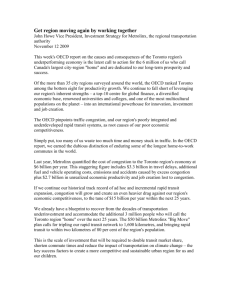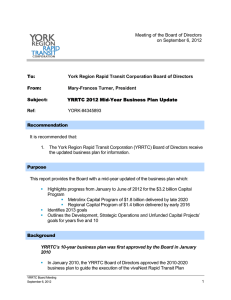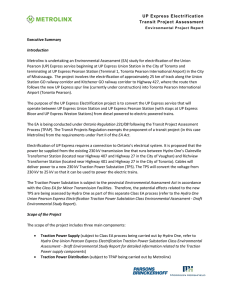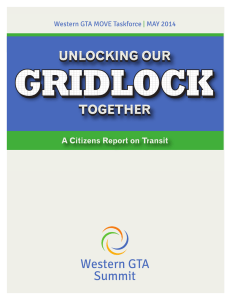2A Michael Sutherland Using Business Cases to get
advertisement
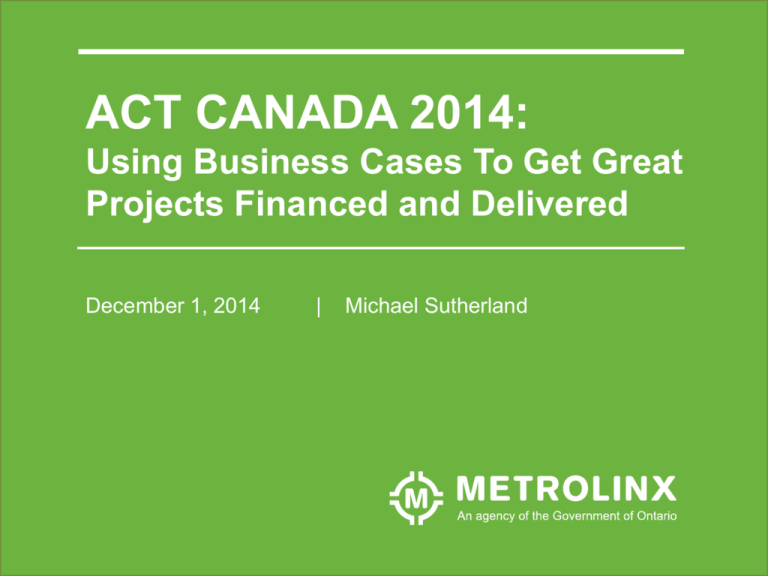
ACT CANADA 2014: Using Business Cases To Get Great Projects Financed and Delivered December 1, 2014 | Michael Sutherland Where we started from “Alignments and technologies will be developed during the project-level Benefits Case Analysis that Metrolinx will carry out in partnership with municipalities and transit agencies for individual projects. When it comes to make decisions on new transit projects, the costs and benefits of all reasonable alternatives need to be evaluated so that the best possible transit projects are built.” – The Big Move (RTP), 2008 The challenge Metrolinx has not published a detailed financial plan, showing what it plans to build, how it will be paid for, and what this will deliver. “Benefit Case Analyses” have not been issued for some schemes. The BCAs that have been issued omit key information. [Important] BCAs...were not made public until we obtained them for this report through a Freedom of Information request. In any case, Metrolinx seems to be ignoring their conclusions…in contravention of its own principle of accountability. – Neptis Foundation Review of Metrolinx’s Big Move, 2013 Recommendations Recommendation 5: Enhance reporting systems for project rationale, schedule, budget, & change Recommendation 14: Enhanced evidence-based project evaluation and selection processes Rec 2: Apply open, evidence-based decision-making to Next Wave projects through the review of the RTP (Big Move) - Metrolinx Investment Strategy Recommendations, 2013 The public’s low trust in transit decision-making can be addressed in part by ensuring that the process for project evaluation and selection is evidence-based and transparent. The Metrolinx Investment Strategy notes that using a comprehensive business case analysis and prioritization framework ‘builds confidence that the right projects are being selected for delivery at the right time and in the right sequence. –Transit Investment Strategy Advisory Panel, 2013 CONFIDENTIAL ADVICE 2 Business Cases and Prioritization Introduction • Business Cases inform decisions about the value of individual projects (including considering project options). • Prioritization builds on Business Cases to inform considerations of how projects compare to each other and how projects may be implemented in phases over time. CONFIDENTIAL ADVICE 3 Annual Board Approval Capital Planning and Phasing: Annual Review Cycle Prioritization = multiple projects Business Cases = individual projects Board Approval Regional Transportation Plan and Corporate Strategic Plan: Major Studies: Board Board Approval Significant Approval Planning and Policy or Individual Project Studies Alternative Finance and Procurement/ Pre-Contract Approval: Vision, Policies, & Projects 10-30% Significant Design Community and Stakeholder Consultation CONFIDENTIAL ADVICE 4 Business Case Methodology A collaborative platform for project evaluation across the organization A problem statement initiates a study; options are developed to respond to the problem statement. Value is measured qualitatively and quantitatively, with evidence gathered in three areas: Strategic & Planning How does the proposed project deliver larger policy objectives? How does the project contribute strategically to the overall network? (look at Regional Transportation Plan policies like shifting mode, reducing congestion) 3 part Business Case Economic & Financial What is the value for money of the project? How efficient is it? How much will it cost? What benefits will it contribute? (benefit:cost ratio, Net Present Value) Deliverability & Operations How is the project best delivered for on-time, on budget results? What is a feasible timeline? How will it be built, operated and maintained? Optimize partnerships, identify risks and opportunities for effective delivery. in London, UK – an audit of the business and investment cases for this rail improvement project CASECONFIDENTIAL STUDY - Thameslink ADVICE 5 http://www.nao.org.uk/wp-content/uploads/2013/06/10164-001-Thameslink-Full-Report.pdf Integrating the Evidence Conceptual • Is the investment supported by a robust case for change that fits with wider public policy objectives? – ‘policy and planning analysis’; • Does the investment show value for money and is financially affordable? – ‘economic and financial analysis’; • Is the investment viable and achievable from an operations and deliverability perspective? – ‘deliverability and operations analysis’ CONFIDENTIAL ADVICE 6 $ Transportation Investment Direct economic impacts Economic Benefits Jobs and associated economic activity from construction and operation Worth measuring, but shouldn’t be used to evaluate projects because these benefits accrue to any construction project. CONFIDENTIAL ADVICE Traditional mobility benefits Includes ridership, trips, travel time savings, reliability, accident avoidance, health benefits, and other benefits Benefit Cost Ratio should be > 1 relevance 7 reliability Agglomeration Benefits Other uncaptured benefits Increasing accessibility in a region to enable more travel interactions and greater productivity Quality of life Greener cities Access to opportunity Reduced inequality Precise land use shaping ~5 - ~100% additional benefits Methods are improving for estimating these benefits Relevant to decisions Difficult to measure in dollars Highlight Business Case Work CONFIDENTIAL ADVICE 8 Supporting Good Investment – Both Large and Small CONFIDENTIAL ADVICE 9 Thank you and Questions? CONFIDENTIAL ADVICE 10 www.metrolinx.com


